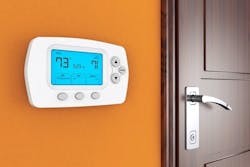Smart Sensor Technology: Reducing HVAC Energy Use
HVAC systems account for 39% of the energy used in commercial buildings in the U.S., according to the Whole Building Design Group. With Internet of Things devices and smart sensor technology becoming more commonplace and available, now is the time to think about using IoT sensors for energy efficiency.
The ACEEE report Smart Buildings: A Deeper Dive into Market Segments found that the average office can save 18% on its annual whole-building energy consumption by installing smart sensor technology.
Smart HVAC options cited in the ACEEE report include:
- Installing occupancy-based wireless thermostats. This can save 5-10% of HVAC energy costs if programmed to allow the HVAC system to reduce its operation when the building or zone is unoccupied.
- Advanced rooftop unit (RTU) controls. RTUs have the potential to cut HVAC energy use by 20-40%, depending on how they are set up and what components are used.
- CO2 demand-controlled ventilation (DCV) sensors, which can be coupled with sensors that detect a building’s occupancy and adjust ventilation accordingly. Though costly to install, they can make the most sense in a building retrofit.
- Smart solar film, which can be programmed to adjust according to the amount of incoming sunlight, can help reduce cooling load by 10-20%.
The Importance of Proper Sensor Placement
When determining where and what is using excess energy and where to save, monthly utility bills only say so much. Kevin Brown, Vice President of Engineering at ABM, suggests looking at granular data, as frequently as information for every 15 minutes. Instead of one data point a month – your utility bill – you will have almost 3,000 points.
“That will tell you things like if your system is running the right amount at night or if all your equipment is starting at same time,” he says.
When determining the right temperature and humidity, it’s important to keep the comfort and productivity of people in the building in mind. The key is to find a zone where people are comfortable and energy is optimized.
Place wireless sensors in key areas:
- High-density areas
- Spaces that aren’t in use to make sure they aren’t running excessively
- At workstations
- Interior walls
If there’s a known issue or complaint from people, well-placed sensors can help determine the problem, Brown suggests. “It could be airflow or sensing and tuning issues, or it could be a problem where you need to put new duct runs or diffusors into a space.”
Reducing Lighting Issues for Energy Savings
HVAC sensors can work alongside sensors tied to window treatments to help with energy efficiency.
A properly placed sensor tied to motorized window treatments can pick up on sunlight and adjust window shading during the course of a day.
“Working together, you won’t necessarily have to have the air conditioning set at a very low temperature, the room won’t get so warm,” says Marvin Gramm, Product Manager at Nice Group USA. “Roller shades can compensate for this, resulting in lower energy usage.”
Motorized shades can cut down on heat and glare, so building personnel are more comfortable and productive.
Gathering Information to Manage the System
To reduce energy for HVAC systems, Brown suggests looking to make improvements to an HVAC system in this order:
- Schedule: Optimize the system to deliver the right temperature at the right time.
- Maintenance: Older systems that still work often get ignored. By knowing how they are doing and tuning them, they can get back to their original operating or beyond.
- Testing and balancing: Make sure the airflow is going to the right place.
Brown also recommends submetering and setting up trend logs. “You have to be able to measure it to manage it,” he says.
Another consideration is the information the sensors collect. The proper software and a person who can control everything will help make the most of the system.
“Control systems need somewhere to put the information, and a programmer can identify and map out proper sensor placement,” Brown says. “As a system gets more complicated, you will need more experts.”
Two hand-picked articles to read next:
About the Author

Valerie Dennis Craven
Content strategist and writer
Valerie Dennis Craven is an experienced writer of commercial and residential buildings and interiors, having previously served as Editorial Director for both BUILDINGS and i+s. Valerie enjoys writing about technology and how it impacts users in the built environment.
